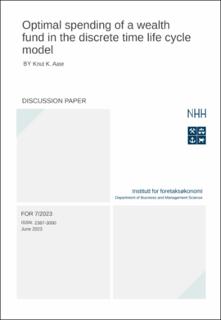Optimal spending of a wealth fund in the discrete time life cycle model
| dc.contributor.author | Aase, Knut K. | |
| dc.date.accessioned | 2023-06-09T11:20:34Z | |
| dc.date.available | 2023-06-09T11:20:34Z | |
| dc.date.issued | 2023-06-09 | |
| dc.identifier.issn | 2387-3000 | |
| dc.identifier.uri | https://hdl.handle.net/11250/3070742 | |
| dc.description.abstract | The paper analyses optimal spending of an endowment fund. We use the life cycle model for both expected utility and recursive utility in discrete time. First we find the optimal consumption and investment policies for both kinds of utility functions. This we apply to a sovereign wealth fund that invests broadly in the international financial markets. We demonstrate that the optimal spending rate, i.e., the consumption to wealth ratio, is significantly lower than the fund’s expected real rate of return. Using the expected return as the spending rate, implies that the fund’s value converges towards 0 with probability 1 and also in expectation, as time goes. For both kinds of long term convergence we find closed form threshold values. Spending below these values secures that the fund will last ”forever”. For reasonable values of the preference parameters, the optimal spending rate is demonstrated to satisfy these long term requirements. | en_US |
| dc.language.iso | eng | en_US |
| dc.publisher | FOR | en_US |
| dc.relation.ispartofseries | Discussion paper;7/23 | |
| dc.subject | Life cycle model | en_US |
| dc.subject | optimal spending rate | en_US |
| dc.subject | endowment funds | en_US |
| dc.subject | expected utility | en_US |
| dc.subject | recursive utility | en_US |
| dc.subject | risk aversion | en_US |
| dc.subject | EIS | en_US |
| dc.subject | consumption to wealth ratio | en_US |
| dc.subject | almost sure convergence | en_US |
| dc.subject | 1st mean convergence | en_US |
| dc.title | Optimal spending of a wealth fund in the discrete time life cycle model | en_US |
| dc.type | Working paper | en_US |
| dc.source.pagenumber | 59 | en_US |
Tilhørende fil(er)
Denne innførselen finnes i følgende samling(er)
-
Discussion papers (FOR) [566]
